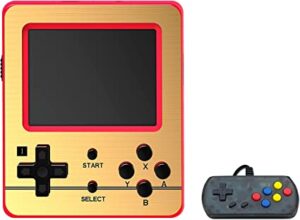| RG FC250 Retro Handheld Price: $10-$15 Find it on: eBay, Amazon, AliExpress  |
Rating: 8.5/10
Pros: Cons: |
There are probably three dozen retro game handhelds on the market right now in the $15 range that do pretty much the same thing. They’ll play a large variety of NES games off a cheap SoC cheaply soldered inside an even cheaper plastic casing. I’ve reviewed several of these so far, but the one I’ve found best in class is the RS-60. And, so, I’ll compare every retro handheld in this price range to that gold standard.
But first, a caveat about the RS-60: While I loved it, it also fell apart quickly. The first device I received was damaged on arrival, and could only load about 20% of the games. I figured this was a one-off, and ordered another. A second device did come, and for several months, worked just fine. But inevitably, because of how thin the device was and how cheaply it was constructed, it became a clunker too.
It’s with that lens that I review the RG FC250 Handheld, which I got on sale for $11 on Amazon. Like all of the devices in this range, it promises hundreds of games in one unit. And like all devices in this range, you only get about 15-20 titles that you’ve heard of, with the rest either terrible homebrews or repeated games. There’s nothing new about that here. I was hoping this device would have Super Mario Bros. 3, but that was missing from the “520 games” that are packed on this SoC. And while there is the original Super Mario Bros. game, it’s overclocked at about 150% and is frustrating to play. Comparatively, the library of the FC250 isn’t as good as the RS-60.
Comparing the form factor of the RG FC250 to the RS-60, the FC250 is considerably larger. The shell is about a half inch wider, but the depth is about 4x that of the RS-60. That comes with benefits, though. The first thing I noticed was that the D-pad and action buttons had considerable depth and travel to them. If you can believe it, the cushion of the D-pad was actually squishier than the D-pad on the Odin Lite. This was a significant upgrade to the clickiness of the RS-60.
The FC250 also has about 40 games with a rumble option, and the unit does shake, though I didn’t find that it added all that much to the gaming experience—it was more of a gimmick, but it does show why the build has a bit more heft. The screen is also brighter than the RS-60. The viewing angles up-and-down were excellent, though the viewing angles left-to-right washed almost immediately.
I’ve only owned this unit for a few weeks now, but it seems like the weight of the FC250 will make it more durable, and I’m confident than several months from now when I’m dusting it out of my desk drawer, it will still work like the first day I received it. Another nice feature of the form factor that you can swap out the 600mAh lithium battery, which is the standard battery for a variety of low-end cellphones. It’s charged with USB-C, another improvement over the RS-60. Other hardware features include a sound wheel, a TV out port, and a controller that acts as a player two.
In the end, the FC250 is a worthy competitor to RS-60. While it is not as pocketable as the RS-60, it’s still also very small and is about the size of a normal men’s wallet. What you get in return (improved controls, screen, USB-C, rumble and TV-out) should make you consider this if you’re in that under $20 range.